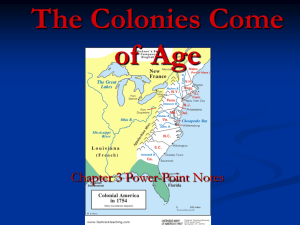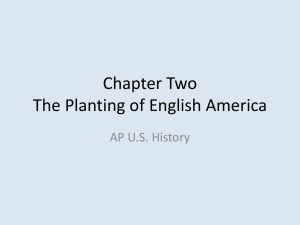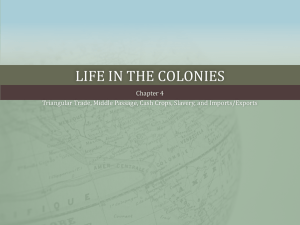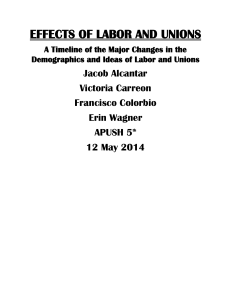Labor in the 1600s During the 1600s, the primary form of labor in the
advertisement
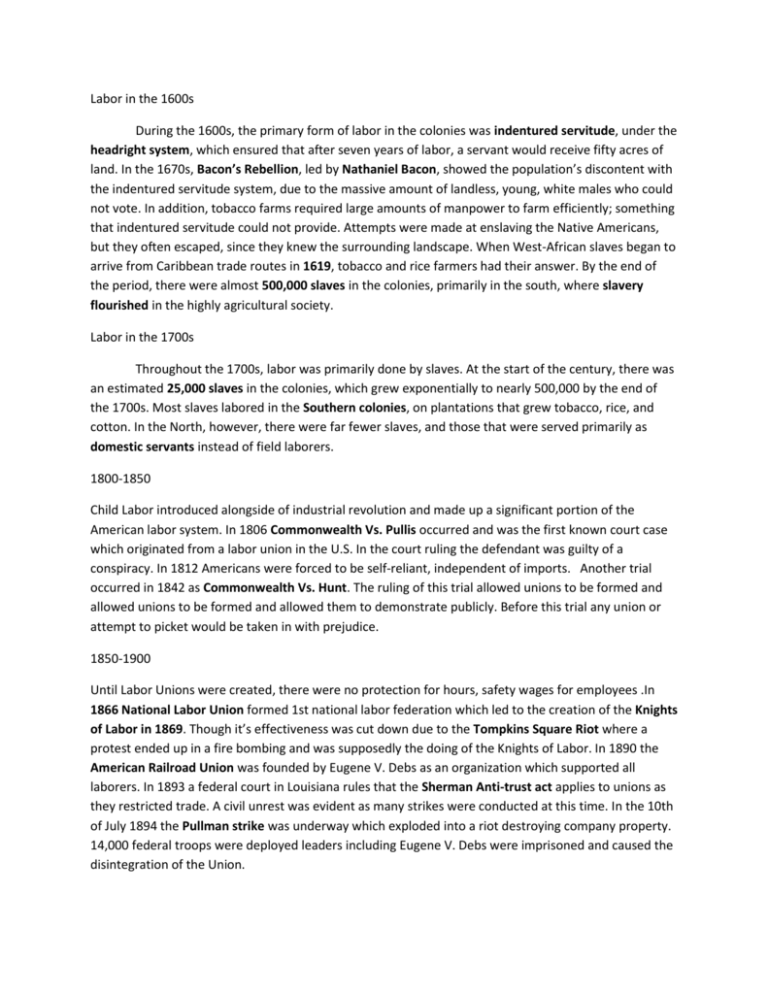
Labor in the 1600s During the 1600s, the primary form of labor in the colonies was indentured servitude, under the headright system, which ensured that after seven years of labor, a servant would receive fifty acres of land. In the 1670s, Bacon’s Rebellion, led by Nathaniel Bacon, showed the population’s discontent with the indentured servitude system, due to the massive amount of landless, young, white males who could not vote. In addition, tobacco farms required large amounts of manpower to farm efficiently; something that indentured servitude could not provide. Attempts were made at enslaving the Native Americans, but they often escaped, since they knew the surrounding landscape. When West-African slaves began to arrive from Caribbean trade routes in 1619, tobacco and rice farmers had their answer. By the end of the period, there were almost 500,000 slaves in the colonies, primarily in the south, where slavery flourished in the highly agricultural society. Labor in the 1700s Throughout the 1700s, labor was primarily done by slaves. At the start of the century, there was an estimated 25,000 slaves in the colonies, which grew exponentially to nearly 500,000 by the end of the 1700s. Most slaves labored in the Southern colonies, on plantations that grew tobacco, rice, and cotton. In the North, however, there were far fewer slaves, and those that were served primarily as domestic servants instead of field laborers. 1800-1850 Child Labor introduced alongside of industrial revolution and made up a significant portion of the American labor system. In 1806 Commonwealth Vs. Pullis occurred and was the first known court case which originated from a labor union in the U.S. In the court ruling the defendant was guilty of a conspiracy. In 1812 Americans were forced to be self-reliant, independent of imports. Another trial occurred in 1842 as Commonwealth Vs. Hunt. The ruling of this trial allowed unions to be formed and allowed unions to be formed and allowed them to demonstrate publicly. Before this trial any union or attempt to picket would be taken in with prejudice. 1850-1900 Until Labor Unions were created, there were no protection for hours, safety wages for employees .In 1866 National Labor Union formed 1st national labor federation which led to the creation of the Knights of Labor in 1869. Though it’s effectiveness was cut down due to the Tompkins Square Riot where a protest ended up in a fire bombing and was supposedly the doing of the Knights of Labor. In 1890 the American Railroad Union was founded by Eugene V. Debs as an organization which supported all laborers. In 1893 a federal court in Louisiana rules that the Sherman Anti-trust act applies to unions as they restricted trade. A civil unrest was evident as many strikes were conducted at this time. In the 10th of July 1894 the Pullman strike was underway which exploded into a riot destroying company property. 14,000 federal troops were deployed leaders including Eugene V. Debs were imprisoned and caused the disintegration of the Union. 1900- Present Day 1900-1932 Formed in 1900 was the National Civic Federation (NCF). Composed of leaders from both big corporations and major trade unions, which included well known leaders from the works of the finance, academia, and government. The goal of the NCF was to develop means to harmonize capital- labor relations, and its chosen instrument for this task was the trade union agreement (now called collective bargaining. Collective bargaining is actually a complicated power relationship that embodies the strengths and weaknesses of both sides. Its existence reviles the power of labor, but the narrowness of the unions and the substance of what is bargained about reflect the power of capital. Unionization is possible when workers can exercise a disruption potential that threatens profits in the late 19th and 20th centuries unions had a high disruptive capacity that was rooted in the difficulty in finding replacement workers in the face of strikes. As the union’s membership grew and the began, making more demands the employer’s dislike of unions resurfaced accordingly. In other words, class conflict once again emerged, which soon led to organized opposition to unions with in the very same employer associations that had been admitted to encourage trade agreements. 1960 Union decline began for two reasons first: corporate resistance stiffened as manufacturing companies faced stronger competitions from a broad end a need to automotive their production processes. Two: the growing diversions between liberals and labor over how to react to a civil rights movement’s demands for integration of neighbor hoods, schools, and work places made the union movement volume able to a numbered corporation attack. 1970-1984 During this time the biggest issue by far in the eyes of the decision makers was inflation, and behind inflation stood their chief cause of inflation, especially in the construction, heavy metals, and automobile industries. 1885-2012 Labor leaders advocated their employ free choice act, which would instruct corporations to recognize and bargen with unions if a majority of their employees signed a card expressing their desire to be represented by a union. Key Terms and Definitions Indentured Servitude- A form of debt bondage, a servant would work a set amount of years in order to pay off his/her traveling cost to the Colonies. Headright system- System that outlines the terms of indentured servitude. In exchange for seven years of labor, an indentured servant would be given a headright, which was fifty acres of land to start their own farm on. Bacon's Rebellion- A class revolt led by Nathaniel Bacon, indentured servants and lower class whites revolted against Governor William Berkeley because of his refusal to defend the outer plantations from Indian attacks. The rebels attacked two Indian tribes in the area, the Occaneechi and the Susquehanock, before marching on Jamestown. The rebellion dissolved after Bacon died of dysentery. Nathaniel Bacon- The leader of Bacon's Rebellion, he was dissatisfied with Governor William Berkeley's leadership, and his failure to react accordingly to Indian attacks. 1619- The first West-African slaves began to first arrive in the colonies in 1619, opening the slave trade and offering a new form of labor on plantations, eventually surpassing the indentured servant. 500,000 Slaves- The estimated number of slaves that were owned in the colonies by the end of the colonial period. 25,000 Slaves- The estimated number of slaves that served landlords in the Colonies by the year 1701. Southern Colonies- South Carolina, North Carolina, Maryland, Virginia and Georgia. Had the highest percentage of slaves in the entirety of the Colonies. Domestic Servant- Most women served as domestic slaves, cooking food and cleaning around the plantation owner’s house. About 80% of female slaves were domestic slaves. Commonwealth v. Pullis- The first reported case arising from a labor strike in the United States. It decided that striking workers were illegal conspirators. Commonwealth v. Hunt- A landmark legal decision issued by the Massachusetts Supreme Judicial Court on the subject of labor unions. Prior to Hunt the legality of labor combinations in America was uncertain. In March 1842, Chief Justice Lemuel Shaw ruled that labor combinations were legal provided that they were organized for a legal purpose and used legal means to achieve their goals. National Labor Union- The first national labor federation in the United States. Founded in 1866 and dissolved in 1873, it paved the way for other organizations, such as the Knights of Labor and the AFL (American Federation of Labor). It was led by William H. Sylvis. Knights of Labor- The largest and one of the most important American labor organizations of the 1880s. Its most important leader was Terence V. Powderly. The Knights promoted the social and cultural uplift of the workingman, rejected Socialism and radicalism, demanded the eight-hour day, and promoted the producers ethic of republicanism. In some cases it acted as a labor union, negotiating with employers, but it was never well organized, and after a rapid expansion in the mid-1880s, it suddenly lost its new members and became a small operation again. Tompkins Square Riot- Occurred on January 13, 1874 when the New York City Police Department crushed a demonstration involving thousands of unemployed in New York City's Tompkins Square Park. American Railroad Union- Founded on June 20, 1893, by railway workers gathered in Chicago, Illinois, and under the leadership of Eugene V. Debs, the ARU, unlike the craft unions, incorporated a policy of unionizing all railway workers, regardless of craft or service. Sherman Anti-Trust Act- The Sherman Antitrust Act is a landmark federal statute on United States competition law passed by Congress in 1890. It prohibits certain business activities that federal government regulators deem to be anticompetitive, and requires the federal government to investigate and pursue trusts, companies, and organizations suspected of being in violation. Pullman Strike- The Pullman Strike was a nationwide conflict in the summer of 1894 between the new American Railway Union (ARU) and railroads that occurred in the United States. The conflict began in the town of Pullman, Illinois, on May 11 when nearly 4,000 employees of the Pullman Palace Car Company began a wildcat strike in response to recent reductions in wages. National Civic Federation- The National Civic Federation (NCF) was an American economic organization founded in 1900 which brought together chosen representatives of big business and organized labor, as well as consumer advocates in an attempt to ameliorate labor disputes. It favored moderate progressive reform and sought to resolve disputes arising between industry and organized labor.


